

Philadelphia Eagles
1949 Joe Muha
(Game Worn)
When a true and certain piece of football history is found, excitement is generated. When it is part of an original uniform, one who studies the phenomenon of “uniform and helmet history” understands its significance, and even a casual observer who may be a die-hard football fan but not a helmet or uniform cognoscente immediately recognizes the importance of the artifact. Those of us of a certain age may not think that a football related object from only sixty-five years ago qualifies as an “artifact,” but it does if its rarity allows it that valued designation. A game worn Philadelphia Eagles helmet from the 1949 and/or 1950 season(s) would certainly meet all of the criteria, and is just as certainly a rare find.
|
|
 |
The beautiful two-tone painted green and silver design is immediately associated with the Eagles’ championship teams of 1948 and ’49, with the leather version of the helmet being worn for the ’48 season. This wonderfully preserved clear shell Riddell RT helmet of the same design was utilized in 1949, and although many football historians refer to the distinctive appearance as “the 1949 Philadelphia Eagles helmet,” it is more accurately one that was worn in both ’49 and 1950. That this specific helmet belonged to one of the most highly respected though little known and hardly recalled members of those great Eagles teams of the late-1940’s, makes it even more valued.
 |
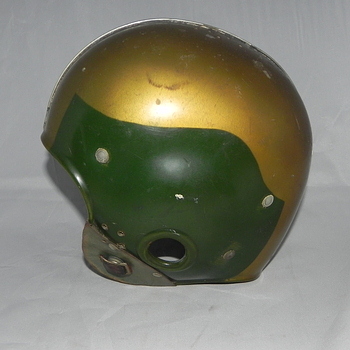 |
The Eagles of the post-World War II years were a powerful amalgam of talent. Coached by Pro Football Hall Of Famer Earle “Greasy” Neale who perhaps could have been the prototype of the “tough love” coach, and led by Pro Football Hall of Fame players halfback Steve Van Buren, end Pete Pihos, center/ linebacker and former Fordham “Block Of Granite” Alex Wojciechowicz, and ’49 rookie Chuck Bednarik, the team most often looked to understated and barely recalled Joe Muha for inspiration and guidance. Among these great players, the obvious leader was quarterback Tommy Thompson, a master at directing Neale’s T-Formation. He was tough, effective, and in every sense a winner despite being slow of foot and having the handicap of being blind in one eye. However, it was fullback and linebacker Joe Muha who was the unspoken pillar of strength for this squad that played for each other with an unsurpassed team loyalty.
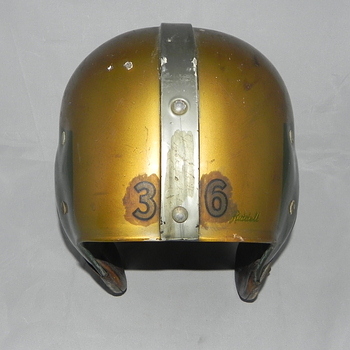 |
 |
Muha had proven his football talent as the Eagles number one draft choice and second overall pick of the 1943 NFL draft, a position he earned as an All American fullback and linebacker at Virginia Military Institute. He had proven his toughness, delaying his entry to the NFL and instead serving with the U.S. Marine Corps Fifth Division as a first lieutenant, fighting at Iwo Jima, receiving a battlefield promotion, and assigned to the occupying forces in Japan. He had proven his intelligence as a top-rated student who would augment his BS degree in Civil Engineering from VMI with a future Masters Degree in Economics from the University Of Southern California and a career as a college professor who taught Economics and Business Mathematics. Returning to the Eagles after the War with VMI teammate and speedy halfback Bosh Pritchard, Thompson, Pihos, and halfback Russ Craft, the Eagles quickly ascended under Neale’s tutelage and innovative offense. Known as “Joltin’ Joe” at VMI and “Jolter” throughout the NFL because of the impact of his blocks and tackles, Muha was called “the best blocker I have ever seen” by Neale and was considered to be the best blocking back in the league by most. As a wide-ranging linebacker and the lead blocker for Van Buren and Pritchard, he was often the forgotten man in the Eagles backfield yet was All Pro in 1948 and after the establishment of two-platoon ball in the NFL, was again All Pro in ’50 as a linebacker. As Neale had also stated that Muha was “the greatest defensive linebacker” in the league, his All Pro selection wasn’t surprising to teammates or opponents. Muha would do the place kicking when needed, which was often, and completed his career as the Eagles all-time leader in punting average, a record that stood until 2013. He was particularly adept at the quick-kick and his eighty-two yard effort in ’48 wasn’t topped until 1989.
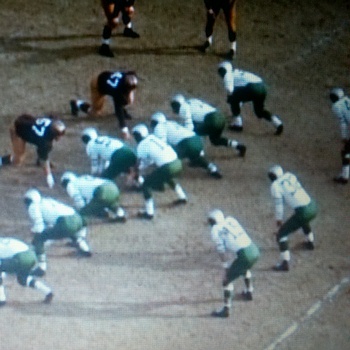 |
 |
As much as his on-the-field accomplishments gave to the success of the team, it was his even-tempered, thoughtful, intelligent, and caring approach that made him a locker room favorite. Often sought out for financial advice and career direction, he was a quiet leader that was quick to design and arrange for the purchase of the team’s championship rings after their two consecutive NFL titles when new ownership failed to deliver. Muha walked away on his own accord, after the 1950 season, deciding to leave the game as a player before incurring serious injury and with the intent of completing his graduate studies. As this coincided with the firing of Neale and the departure of many of the team’s long established stars, it also marked the start of disappointing football in Philadelphia. Muha kept his hand in the game however. While pursuing his graduate degree at USC and advanced studies at both UCLA and Los Angeles State University, he was an effective and well respected assistant coach at USC and then spent a year coaching the Chicago Cardinals. Former USC quarterback Rudy Bukich who later played in the NFL for fourteen years, stated numerous times that during his collegiate career, he was at odds with Trojan head coach Jess Hill and most of the coaching staff, yet it was Muha and former Giants great Mel Hein who were assistants that continuously displayed their humanity and caring side that encouraged him and future pro great Charley Ane to remain at school and work to fulfill their potential. In addition to being a respected and beloved defensive coach, he developed USC punter Desmond Koch into the best in the nation. He entered into a full time commitment as a teacher and college professor but also served the NFL as an on-field official for fifteen years, and was an alternate for the 1968 Super Bowl. This great Eagles helmet, such a wonderful piece of memorabilia and history is perhaps granted a bit more distinction having been worn by a man who achieved so much in his lifetime.
The silver and Kelly green plastic RT helmet paint pattern was copied from the leather models worn in 1948. This initial Eagles plastic helmet is a clear shell model with the very distinctive Eagles two tone paint that was applied inside of the shell. The silver paint, which so nicely contrasted with the team’s official Kelly green color, has over the decades, oxidized to a tarnished, gold hue. The oxidation of the paint has not however, obscured the one-inch, two-tone “office door” player identification numerals applied to the rear of the shell. This type of number decal was frequently utilized by both professional and collegiate teams to identify the player’s helmet and Muha’s number 36 still stands out boldly. The center strip, used to hold the two halves of the Riddell RT helmets together has maintained its silver color nicely after so long a period of time, as its composition differed from that of the shell halves.
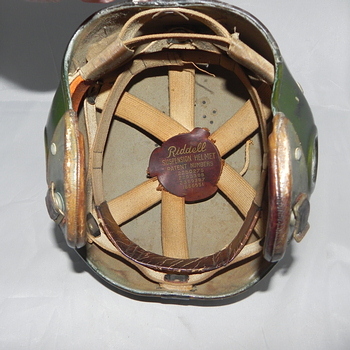 |
For 1950, the Eagles played the College All Stars in what was an annual summer contest dating from 1934. They entered the field in their usual silver and Kelly green helmets, but when they opened the regular season on September 16 at home against former All American Football Conference champions Cleveland Browns, they were donned in new-look shells that were all Kelly green. In a number of games, including the October 15 contest against the Colts, November 12 versus the Redskins, and the second meeting against the Browns on December 3, they chose the silver and green helmets.
Careful inspection of this helmet reveals the four holes that were drilled in order to attach the tie-on Schutt mask. Muha, like most of the Eagles, did not wear a mask for the 1949 season, but it could be proposed that many, if not most of the helmets readied for the ’50 season were drilled for this specific mask. Certainly many on the squad did include the protective face mask for the 1950 season on both the green and two-tone versions of the Eagles helmets, although Muha chose to continue his practice of not wearing a face mask on his helmet. With or without a mask, this definite piece of pro football history is a beautiful and meaningful reminder of an earlier and significant era.
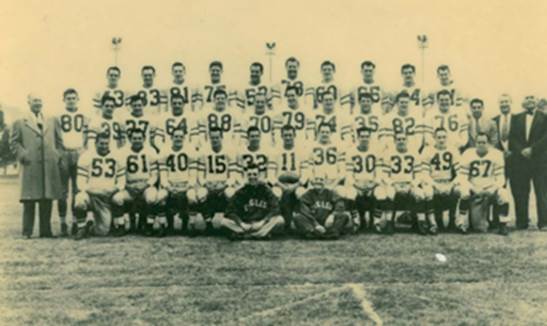 |